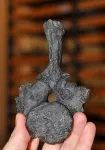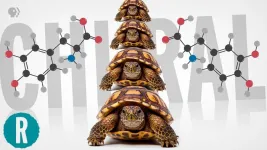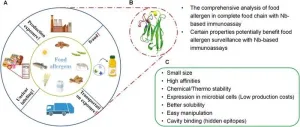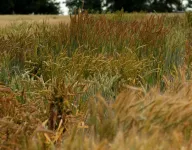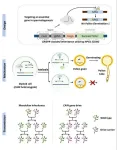(Press-News.org) A new smartphone face-screening tool could help paramedics to identify stroke in seconds – much sooner and more accurately than is possible with current technologies.
Strokes, which affect millions of people globally, occur when the blood supply to part of the brain is interrupted or reduced, which prevent brain tissue from getting oxygen and nutrients. A few minutes of delay can result in permanent damage to the brain cells.
A team of biomedical engineers at RMIT University developed the AI capabilities behind the software technology and has published their results in Computer Methods and Programs in Biomedicine.
PhD scholar Guilherme Camargo de Oliveira, from RMIT and São Paulo State University, led this research under the supervision of team leader Professor Dinesh Kumar.
“Early detection of stroke is critical, as prompt treatment can significantly enhance recovery outcomes, reduce the risk of long-term disability, and save lives,” said Kumar from RMIT’s School of Engineering.
“We have developed a simple smartphone tool that paramedics can use to instantly determine whether a patient is post-stroke and then inform the hospital before the ambulance leaves the patient’s house.”
The smartphone tool, which has an accuracy rating of 82% for detecting stroke, would not replace comprehensive clinical diagnostic tests for stroke, but could help identify people needing treatment much sooner.
“Our face-screening tool has a success rate for detecting stroke that compares favourably to paramedics,” Kumar said.
Strokes can be difficult to spot
Symptoms of stroke include confusion, partial or complete loss of movement control, speech impairments and diminished facial expressions.
“Studies indicate that nearly 13% of strokes are missed in emergency departments and at community hospitals, while 65% of patients without a documented neurological examination experience undiagnosed stroke,” Kumar said.
“Many times, the signs are very subtle. On top of that, if first responders are working with people who are not their race or gender – most notably women and people of colour – it is more likely that the signs will be missed.
“This rate can be even higher in smaller regional centres. Given that many strokes occur at home and initial care is often provided by first responders in non-ideal conditions, there is an urgent need for real-time, user-friendly diagnostic tools.”
How the technology works
The novel AI-driven technology uses the power of facial expression recognition to detect stroke by analysing facial symmetry and specific muscle movements, known as action units.
The Facial Action Coding System (FACS), initially developed in the 1970s, categorises facial movements by the contraction or relaxation of facial muscles, providing a detailed framework for analysing facial expressions.
“One of the key parameters that affects people with stroke is that their facial muscles typically become unilateral, so one side of the face behaves differently from the other side of the face,” de Oliveira said.
“We’ve got the AI tools and the image processing tools that can detect whether there is any change in the asymmetry of the smile – that is the key to detection in our case.”
Video recordings of facial expression examinations of 14 people with post-stroke and 11 healthy controls were used in this study.
Next steps
The team plan to develop the smartphone tool into an App in collaboration with healthcare providers so that it will be able to detect other neurological conditions that affect facial expressions.
“We want to be as sensitive and specific as possible. We are now working towards an AI tool with additional data and where we are going to be considering other diseases as well,” Kumar said.
“Collaboration with healthcare providers will be crucial to integrate this App into existing emergency response protocols, providing paramedics with an effective means of early stroke detection.”
The researchers from RMIT partnered with São Paulo State University in Brazil on this research.
‘Facial expressions to identify post-stroke: A pilot study’ is published in Computer Methods and Programs in Biomedicine (DOI: 10.1016/j.cmpb.2024.108195).
MULTIMEDIA FOR MEDIA USE
Short YouTube video about the innovation: https://youtu.be/F9_YmKiJlCU
This video and associated photos are available for download and use in the media (a document with suggested captions and attribution details is also provided) via this link: https://spaces.hightail.com/space/cn7DReLlvE
END
Face screening tool detects stroke in seconds
2024-06-17
ELSE PRESS RELEASES FROM THIS DATE:
Making this Parkinson's drug is just turtles all the way down (video)
2024-06-17
WASHINGTON, June 17, 2024 — L-DOPA is the best drug we have for Parkinson’s disease, but its molecular mirror image, D-DOPA, causes dangerous side effects. Making L-DOPA without also making D-DOPA is surprisingly hard and requires a specific kind of molecule to pull off. But that specific molecule must be made from a different and equally specific molecule. In this video, our host, George Zaidan, explains how one of the winners of the 2001 Nobel Prize in Chemistry pulled it off, and why "chiral synthesis," as it's called, is really just turtles all the way down. https://youtu.be/_cb09XB07LQ?si=BuMEI5fOuHmuQlkZ
Reactions is a video series ...
Camelid nanobodies: Transforming food allergen analysis
2024-06-17
Recent advancements show nanobodies from camelid antibodies excel in food allergen detection with superior stability, specificity, and cost-effectiveness. This innovative approach aims to improve accuracy and efficiency, crucial for preventing severe allergic reactions. The study highlights nanobodies' potential in reliable immunoassays, addressing rising food allergies and enhancing safety measures.
Food allergies pose significant health risks, affecting millions worldwide, with the prevalence rising over the past decades. Traditional detection methods, such as monoclonal and polyclonal antibodies, are often costly, labor-intensive, and prone to cross-reactions. The need for ...
Federal study examines care following nonfatal overdose among Medicare beneficiaries; identifies effective interventions and gaps in care
2024-06-17
Researchers from the Substance Abuse and Mental Health Services Administration (SAMHSA), the National Institutes of Health’s (NIH) National Institute on Drug Abuse (NIDA), Centers for Medicare & Medicaid Services (CMS), and the Centers for Disease Control and Prevention (CDC) found that among a cohort of 137,000 Medicare beneficiaries who experienced a nonfatal overdose in 2020, almost 24,000 (17.4%) experienced a subsequent nonfatal overdose, and about 1,300 (1%) died from overdose in the following year. Results were published today in JAMA Internal Medicine, identifying both effective interventions and significant gaps in care.
“People who have experienced ...
Maternal inheritance of Alzheimer’s disease tied to increased risk of developing disease
2024-06-17
KEY TAKEAWAYS
Mass General Brigham researchers analyzed 4,400 cognitively unimpaired adults with amyloid imaging, finding increased amyloid in those who reported that their mothers had symptoms of Alzheimer’s disease (AD).
Increased amyloid, a biomarker of AD, was also found in those with a history of the disease on both sides of their family and in those whose fathers had an early onset of symptoms.
The study suggests that a person’s maternal versus paternal family history could ...
Epidemiologic features of recovery from SARS-CoV-2 infection
2024-06-17
About The Study: More than 1 in 5 adults did not recover within 3 months of SARS-CoV-2 infection in this cohort study. Recovery within 3 months was less likely in women and those with preexisting cardiovascular disease and more likely in those with COVID-19 vaccination or infection during the Omicron variant wave.
Corresponding Author: To contact the corresponding author, Elizabeth C. Oelsner, M.D., M.P.H., email eco7@cumc.columbia.edu.
To access the embargoed study: Visit our For The Media website at this link https://media.jamanetwork.com/
(doi:10.1001/jamanetworkopen.2024.17440)
Editor’s Note: Please see the article for additional information, ...
Electronic cigarettes vs varenicline for smoking cessation in adults
2024-06-17
About The Study: This randomized clinical trial found that varenicline and nicotine-containing electronic cigarettes were both effective in helping individuals in quitting smoking conventional cigarettes for up to 6 months.
Corresponding Author: To contact the corresponding author, Anna Tuisku, Ph.D., email anna.tuisku@lapha.fi.
To access the embargoed study: Visit our For The Media website at this link https://media.jamanetwork.com/
(doi:10.1001/jamainternmed.2024.1822)
Editor’s Note: Please see the article ...
Risk factors for long COVID revealed
2024-06-17
NEW YORK, NY (June 14, 2024)--Early in the pandemic, many people who had SARS-Cov-2 infection or COVID-19 began to report that they couldn’t shake off their symptoms even after a month or more—unusually long for a viral infection of the upper respiratory tract—or developed new, persistent symptoms soon after the infection cleared.
Although it’s still not clear what causes post-COVID-19 conditions or “long COVID” (symptoms and conditions that develop, linger, or reoccur weeks or months after SARS-CoV-2 infection), a new study by researchers at Columbia University Vagelos College ...
Ancient polar sea reptile fossil is oldest ever found in Southern Hemisphere
2024-06-17
An international team of scientists has identified the oldest fossil of a sea-going reptile from the Southern Hemisphere – a nothosaur vertebra found on New Zealand’s South Island. 246 million years ago, at the beginning of the Age of Dinosaurs, New Zealand was located on the southern polar coast of a vast super-ocean called Panthalassa.
Reptiles first invaded the seas after a catastrophic mass extinction that devastated marine ecosystems and paved the way for the dawn of the Age of Dinosaurs almost 252 million years ago. Evidence for this evolutionary milestone has only been discovered in a few places around the world: on the Arctic island of Spitsbergen, northwestern North ...
Finding hidden genetic treasure: Study uncovers untapped diversity in historic wheat collection
2024-06-17
A decade-long collaborative study has discovered huge genetic potential that is untapped in modern wheat varieties.
The international study which appears in Nature reveals that at least 60% of the genetic diversity found in a historic collection of wheat is unused providing an unprecedented opportunity to improve modern wheat and sustainably feed a growing global population.
To make this discovery, a cross-institutional collaboration led by Dr Simon Griffiths, at the John Innes Centre and Professor Shifeng Cheng at the Agricultural Genomics Institute at Shenzhen, Chinese Academy of Agricultural Sciences (CAAS), studied the A.E. Watkins Landrace Collection, a ...
Researchers develop plant gene drive system for enhanced trait inheritance
2024-06-17
A collaborative research team led by QIAN Wenfeng from the Institute of Genetics and Developmental Biology (IGDB) of the Chinese Academy of Sciences and Peking University has developed a plant gene drive system called CRISPR-Assisted Inheritance utilizing NPG1 (CAIN), which, according to the researchers, uses a toxin-antidote mechanism in the male germline to override Mendelian inheritance in plants.
Their findings were published in Nature Plants.
In nature, gene inheritance typically follows Mendel's laws, which provide an equal chance for alleles to pass on to ...

